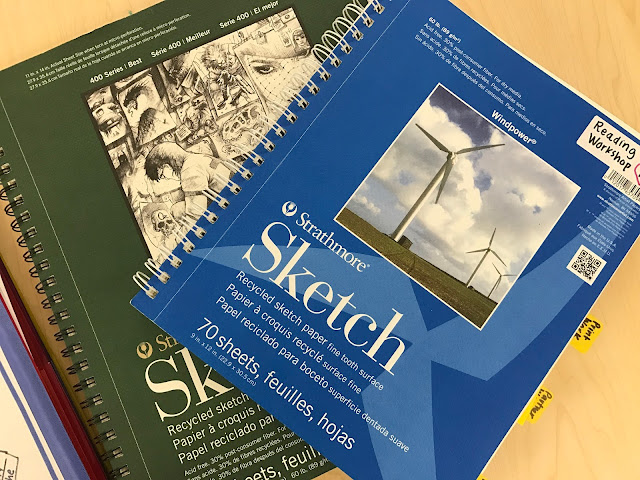we were introduced to this concept by celena larkey, kate and maggie roberts and jennifer serravallo. a teacher toolkit can be used during a one-on-one conference or during small group instruction.
 |
a toolkit is a collection of tools that help teach our tiny readers and writers.
celena larkey shared lot of different purposes for creating a toolkit but the definition that resonated with us the most is that a toolkit can keep our teaching memorable.
for today's blog post, we are going to focus on the demonstration/ strategy notebook. this is a large art book in which we can create visual tools to help our teaching.
teaching with a toolkit can help our teaching stick too. having a teacher toolkit can also help us reach lots of different learners in our classroom. we all know that our teaching is stronger when we don’t just tell our kids what to do but to actually show them.
people remember:
10% of what they hear
20% of what they read
80% of what they see and do
we often leave a post-it reminder with the child of what was taught
our teaching toolkits gives us a resource to use right at our fingertips. we think creating toolkits helps us to dig deeper into the unit we are about to teach and figure out ways to reach our readers and writers.
laura often puts reminder post-it notes of possible teaching points in her toolkit
our teaching toolkits gives us a resource to use right at our fingertips. we think creating toolkits helps us to dig deeper into the unit we are about to teach and figure out ways to reach our readers and writers.
laura often puts reminder post-it notes of possible teaching points in her toolkit
one of the biggest obstacles we found with making toolkits is the time it takes. we all agree that a toolkit can have a huge impact on our teaching but the reality is… how can I teach and make this toolkit and try to use it in the classroom?
so below are some of tips that have helped us get started:
Tip 1: making a toolkit is a process that you can create slowly over time.
Tip 2: decide what kind of tool works for you. do you want to create a toolkit with a binder or a demonstration notebook? our favorite notebooks are Strathmore sketch books (really melissa's favorite).
Tip 3: think about organizing your notebook to support your teaching. at first we were teaching lessons and putting lessons in the demonstration book randomly. we realized it would be better if our demonstration notebook had parts that go with our teaching.
For example in kindergarten for personal narrative writing our writing toolkit may go in this order: storytelling, drawing, topic idea, sounding out words, etc.,
tip 4: go to your GO TO books and get some ideas for your toolkit. our kindergarten team was recently creating a toolkit for reading workshop and they used the fountas and pinnell continuum, kathy collins growing readers book and jenn serravallo’s strategy lesson book. Make a list of possible ideas before you begin. If you work with a team, remember many “hands make light work.”
tip 5: don’t be overwhelmed remember it’s a process.
we hope our tiny tips will help you get started!
If you are making toolkits what is working for you?
jessica & laura & melissa
jessica & laura & melissa








No comments:
Post a Comment